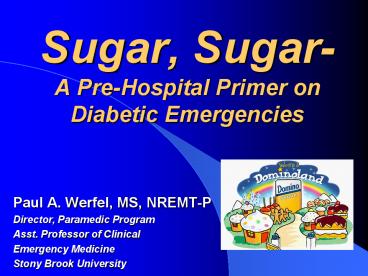Sugar, Sugar A PreHospital Primer on Diabetic Emergencies - PowerPoint PPT Presentation
1 / 26
Title:
Sugar, Sugar A PreHospital Primer on Diabetic Emergencies
Description:
They produce no insulin due to auto immune destruction of beta-cells ... Polydipsia. Acidosis: Abdominal pain. Nausea & vomiting. Acetone odor to breath (fruity) ... – PowerPoint PPT presentation
Number of Views:701
Avg rating:3.0/5.0
Title: Sugar, Sugar A PreHospital Primer on Diabetic Emergencies
1
Sugar, Sugar- A Pre-Hospital Primer on Diabetic
Emergencies
- Paul A. Werfel, MS, NREMT-P
- Director, Paramedic Program
- Asst. Professor of Clinical
- Emergency Medicine
- Stony Brook University
2
BACKGROUND
- Diabetes is a chronic disease that requires long
term care - Devastating complications
- Disproportionately expensive
- 4.6 of US population but 14.6 of all direct
care expenses in 1994
3
PATHOPHYSIOLOGY Type 1
- Insulin dependent
- Younger, leaner patients
- They produce no insulin due to auto immune
destruction of beta-cells - Without insulin, acidosis and ketoacidosis
develop
4
PATHOPHYSIOLOGY Type 2
- Typically gt40 yr.
- Family history
- Low insulin
- 90 are obese
- Do not develop DKA
- May be insulin requiring, not dependent
- Loose weight and no meds
5
DEMOGRAPHICSType 1
- Frequency
- 16 million-10are type 1
- Race
- Caucasians more so than blacks (Lowest rate of
type 1) - Sex
- Malefemale 11
- Age
- Juvenile onset
- mean age is 8-12 yr.
- peaks in adolescence-girls 1.5 yr. ahead of boys
6
DEMOGRAPHICSType 2
- Frequency
- 16 million-90 are type 2
- Race
- Type 2 is more prevalent in Hispanic, Native
American and African-American demographics - Sex
- Femalegtmale in Caucasian populations
- Age
- Type 2 is becoming more common because people are
living longer, young obesity - HFCS- Implications
7
MORTALITY / MORBIDITYType 1 and 2
- Related to short and long term complications
- Infections
- Amputations, renal disease
- MI, CVA
- Micro-vascular
- Neuropathies
- Retinopathy
- Major cause of blindness in 20-74 age group
8
HISTORY
- Type of diabetes
- Duration
- Inquire about treatment
- Diet, oral meds, insulin
- Self Monitoring
- Ask About
- Retinopathy
- Nephropathy
- HTN- Meds?
- Coronary Artery disease?
- Meds, Hx,
- Peripheral Artery disease?
- CVA, Infections, diabetic foot, ulcers
9
HYPOGLYCEMIA
- Blood glucose lt80mg/dl
- Symptoms commonly occur when levels lt60mg/dl
- Can occur in non-diabetics due to
- Physical exertion
- ETOH, drugs, pregnancy, lactation
10
HYPOGLYCEMIACauses
- In diabetics
- Too much insulin
- To much oral hypoglycemic med.
- Decreased dietary intake (missed meal)
- Unusual physical activity
- Emotional stress
INSULIN
SUGAR
11
HYPOGLYCEMIALess common causes
- Alcoholism
- Adrenal problems
- Liver disease
- Malnutrition
- Sepsis
- Hypothermia
- Cancer
- Pancreatic tumor
12
HYPOGLYCEMIASigns Symptoms
- Rapid onset
- Nervousness
- Irritability
- Combative behavior
- Weakness
- Confusion
- Appearance of intox
- Weak, rapid pulse, cool, clammy skin
- Drowsiness, seizures, coma
13
HYPOGLYCEMIAPearls/Pitfalls
- Suspect this in any diabetic with behavioral
change, confusion or unconsciousness - TRUE EMERGENCY!
- Dont assume intox!
14
DIABETIC KETOACIDOSIS
- Absence of insulin
- Glucose does not enter the cell and accumulates
in blood - Cells starve and burn fats, producing ketones and
acidosis - These dehydrate the cells and produce massive
oncotic diuresis - Results include seizures and dysrhythmias
15
DIABETIC KETOACIDOSIS Signs SymptomsSlow in
Onset (12-48 hours)
- Diuresis
- Warm, dry skin
- Dry mucous membranes
- Tachycardia, thready pulse
- Orthostatics
- Polyuria
- Polydipsia
- Acidosis
- Abdominal pain
- Nausea vomiting
- Acetone odor to breath (fruity)
- Kussmauls respiration
- Decreased level of consciousness.
16
DIABETIC KETOACIDOSISPearls/Pitfalls
- DKA patients are very seldom deeply comatose. If
this is the case, assess for a cause of the coma,
like stroke, head trauma, or drug overdose
17
HYPEROSMOLAR HYPERGLYCEMIC NONKETOTIC COMA (HHNK)
- Life threatening emergency, occurs in older type
II or undiagnosed diabetics - There is residual insulin, enough to prevent
ketoacidosis, but not enough to permit cellular
uptake of glucose
18
HYPEROSMOLAR HYPERGLYCEMIC NONKETOTIC COMA (HHNK)
- Hyperglycemia produces hyperosmolar state, and
osmotic diuresis, dehydration. - These folks have greater hyperglycemia because
they are more dehydrated and are not ketotic
19
HYPEROSMOLAR HYPERGLYCEMIC NONKETOTIC COMA
(HHNK)Precipitating Causes
- Type II diabetes
- Old age
- Cardiac/renal disease
- Inadequate insulin
- Increased insulin requirements
- Stress,infection, trauma,burns,MI
- Medications
- Steroids,thiazides
20
HYPEROSMOLAR HYPERGLYCEMIC NONKETOTIC COMA
(HHNK)Signs Symptoms
- Weakness,thirst
- Polyuria
- Weight loss
- Extreme dehydration
- Flushed dry skin
- Dry mucous membranes
- Poor skin turgor
- Orthostatics
- AMS
- Tachycardia
- Hypotension
- Tachypnea
21
ASSESSMENT OF THE DIABETIC PATIENT
- High index of suspicion
- Always transport
- Beware of atypical presentation of MI in patients
with a diabetic history
22
TREATMENT
- Airway management
- High concentration of oxygen
- Vent. Support-if needed
- Draw blood
- IV saline
23
TREATMENT
- Glucometers
- Whats the deal with them?
- Oral Glucose
- When, and when not
24
TREATMENT
- HYPOGLYCEMIA
- Dextrose, if IV access is available
- Glucagon- IM
- DKA/HHNK
- Fluid, Fluid, Fluid
25
Questions?
26
Thank You!































